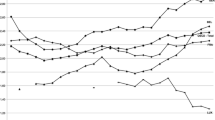Abstract
The aim of this paper is to study the knowledge production of Colombian universities in terms of their accumulation of intellectual capital (IC). We observe Colombian universities’ publications between 1958 and 2008, categorizing each university according to growth trends in its scientific publications: early exponential growth, late exponential growth, and linear and irregular growth. This work describes the relationships between these growth trends and IC accumulation. It presents an historical description of some institutional changes in Colombian universities that improved the research activity. In addition, we present an empirical study of IC accumulation in universities from the three growth trend categories between 2003 and 2009. We suggest that the adapting capacity, the accumulation time, and the strategies of IC accumulation related to feedback structures are key factors in explaining the differences in knowledge production between growth categories of Colombian universities. The results show critical differences—on orders of magnitude—in IC accumulation across the three categories. Therefore, it would be possible to define a roadmap to improve the knowledge production in Colombian universities.








Similar content being viewed by others
Notes
The data was retrieved on April 2010. The search strategy used was “cu = (Colombia)”.
References
Acosta, M. S., Caicedo, S. D., Arias, D. L., Lucio, J., & Aldana, L. C. (2010). Indicadores de ciencia y tecnología. Colombia 2010, ed. Bogotá: Observatorio Colombiano de Ciencia y Tecnología -OCyT.
Aldana, E. (2010). El rol de las universidades en el desarrollo científico-tecnológico: 1998–2007, ed. Chile: Centro Interuniversitario de Desarrollo (CINDA).
Bernardez, M. (2008). Capital intelectual: creación de valor en la sociedad del conocimiento. Bloomington, IN: AuthorHouse.
Bonaccorsi, A., & Daraio, C. (2007). The differentiation of the strategic profile of higher education institutions. New positioning indicators based on microdata. Scientometrics, 74, 15–37. doi:10.1007/s11192-008-0101-8.
Bonaccorsi, A., Daraio, C., & Simar, L. (2006). Advanced indicators of productivity of universities. An application of robust non parametric methods to Italian data. Scientometrics, 66, 389–410. doi:10.1007/s11192-006-0028-x.
Bontis, N. (1998). Intellectual capital: An exploratory study that develops measures and models. Management Decision, 36(2), 63–76. doi:10.1108/00251749810204142.
Bucheli, V., Daza, S., & Villaveces, J. L. (2008). La investigación en Uniandes 2007: elementos para una política (Chapter 2, pp. 63–103). Universidad de Los Andes, Vicerrectoría de Investigaciones y Doctorados. Bogotá: Ediciones Uniandes.
Bucheli, V., Diaz, A., & Zarama, R. (2011). The growth of the scientific production of colombian universities: an intellectual capital-based approach. In P. N. J. L. Ed Noyons (Ed.), The 13th biennial International Conference on Scientometrics and Informetrics. Proceedings of ISSI 2011 (pp. 135–142). Durban: International Society for Scientometrics and Informetrics.
Catanzaro, M., Caldarelli, G., & Pietronero, L. (2004). Social network growth with assortative mixing. Physica A: Statistical Mechanics and its Applications, 338, 119–124. doi:10.1016/j.physa.2004.02.033.
Janger, J. (2005). The research and development system in Austria—input and output indicators. Monetary Policy & the Economy,1, 43–57. Retrieved from http://www.oenb.at/en/img/mop_2005_1_analyses3_tcm16-26926.pdf. Accessed 2 July 2011.
Jin, B., & Rousseau, R. (2005). Evaluation of research performance and scientometric indicators in china. In H. Moed, W. Glnzel, & U. Schmoch (Eds.), Handbook of quantitative science and technology research (pp. 497–514). Netherlands: Springer. doi:10.1007/1-4020-2755-923.
Marr, B., & Moustaghfir, K. (2005). Defining intellectual capital: A three dimensional approach. Management Decision, 43(9), 1114–1128. doi:10.1108/00251740510626227.
Meritum. (2011). Guidelines for managing and reporting on intangibles (intellectual capital report). www.pnbukh.com/site/files/pdffiler/MERITUMGuidelines.pdf. Accessed 2 July 2011.
Newman, M. (2002). Assortative mixing in networks. Physical Review Letters, 89. doi:10.1103/PhysRevLett.89.208701.
Price, D. (1976). A general theory of bibliometric and other cumulative advantage processes. Journal of the American Society for Information Science, 27, 292–306.
Price, D. (1986). Little science, big science and beyond. New York: Columbia University Press.
Santelices, B. (2010). El rol de las universidades en el desarrollo científico y tecnológico: educación superior en Iberoamérica: informe 2010 (1st ed.). Santiago, Chile: Secretaria General Iberoamericana; Universia; Cinda.
Stewart, T. (1999). Intellectual capital: the new wealth of organizations (1st ed.). New York: Currency/Doubleday.
Villaveces, J. L., & Forero, C. (2007). Cincuenta años de ciencia en Colombia, 1955–2005, ed. Edition. Bogotá: Fundación Alejandro Angel Escobar.
Acknowledgments
The authors would like to acknowledge the contributions of information from Centre de Recherche en Epistémologie Appliqué (CREA) (Project ECOS-NORD Towards multilevel reconstruction of scientific socio-semantic dynamics). The authors would also like to thank Dr. Eduardo Aldana Valdés for his valuable comments and suggestions and for his contribution to the data about Colombian universities. We also acknowledge the financial support of CEIBA, Colciencias, and the Faculty of Engineering at the Universidad de los Andes. We thank the financial support of Fondecyt Grant No. 1110135.
Author information
Authors and Affiliations
Corresponding author
Appendix
Rights and permissions
About this article
Cite this article
Bucheli, V., Díaz, A., Calderón, J.P. et al. Growth of scientific production in Colombian universities: an intellectual capital-based approach. Scientometrics 91, 369–382 (2012). https://doi.org/10.1007/s11192-012-0627-7
Received:
Published:
Issue Date:
DOI: https://doi.org/10.1007/s11192-012-0627-7




